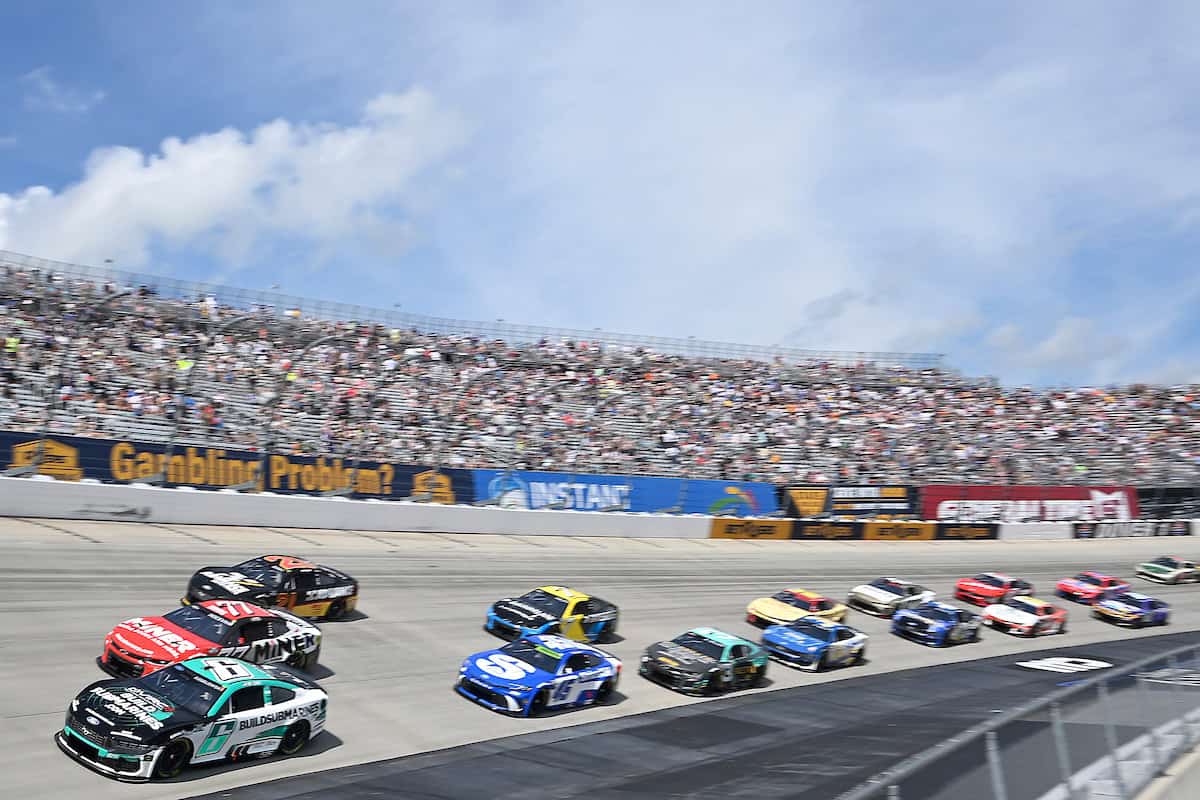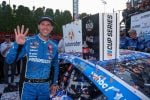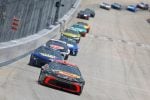Sunday’s (July 20) Autotrader EchoPark Automotive 400 at Dover Motor Speedway had its moments. Thanks to a red flag for rain and double overtime, restarts allowed drivers a chance to make a run at leader Denny Hamlin. First Christopher Bell and then Chase Briscoe were able to race Hamlin into the first corner on restarts, but with Hamlin choosing the dominant outside line, neither was able to clear him (and Bell’s spin trying was what afforded Briscoe the opportunity).
Had it not been for the rain delay and subsequent caution, it would have been the worst race of the summer. Even with that injection of drama, it’s a solid contender.
Give NASCAR credit where it’s due: the sanctioning body tried. Moving the race to midsummer allowed for a racing surface as hot and slick as concrete gets, and a new tire compound from Goodyear made for a little pit strategy and a well-rubbered surface, at least until it rained.
NASCAR, to its credit, has taken some swings at making the Next Gen racecar better on the series’ shorter tracks of a mile and less.
It’s just not enough.
NASCAR has resisted a higher horsepower package for those tracks, a decision which makes little sense given that it has the potential to help and the idea is almost universally popular with teams and fans alike. At this point, it’s the simplest thing NASCAR can throw at this particular car to see if it sticks. And even if NASCAR reverses course on horsepower, it might be too little, too late.
Which is why, after three-quarters of a century, NASCAR is at a crossroads, and the decisions are going to alter the sport forever, because something’s got to give.
Is there a way forward for NASCAR without sacrificing the past for the future—or the future for the past?
None of the answers are simple, and none are going to leave the sport unchanged. It would be nice if it were as easy as going back to a full-season championship with a racecar that matched the body of its showroom counterpart with 900 horses under the hood and teams making their own modifications, albeit a few less than legal.
Through some beautiful rose-colored glasses, that’s all the sport needs. On some level, at its very core, it is. But there’s too much time and space between now and then, so much water under the bridge.
Television rights cost too much for the broadcast networks to relinquish control of the schedule entirely to NASCAR. Even if the sanctioning body was willing to admit that the Chase and playoffs were mistakes, if TV wants them to drum up drama and maybe drive ratings, they’ll remain. More than 20 years in, now, they’re unlikely to budge.
And right now, until everything else is addressed, it would be throwing fans a bone at best, and a pretty bare one at that. If the racing isn’t compelling, the title race is secondary.
The Next Gen car isn’t all bad. It has improved the racing at intermediate ovals to the point where some of those races have become classics, with finishes as memorable as any era of the sport. NASCAR addressed safety issues that arose, and the cars are safer than a couple of years ago.
They’re pretty basic to look at, with the only distinguishing features anymore being the nose and rear clips, but the manufacturers are behind them. Win on Sunday, sell on Monday may be a dying concept, but manufacturer backing gives teams a lot to work with in terms of research, development, driver simulator time, and other support.
Horsepower aside, as that would be the easiest major change for teams to make, creating a car that races equally well on short tracks, intermediates and road courses has been as elusive as capturing a handful of fog for years, decades. Take into consideration that the cars need to at least vaguely outwardly resemble something found on a showroom floor, and it gets harder still.
Street cars, the ones that sell on Monday, have changed drastically in the last 40 years. They’re no longer boxy and angular, but sleek and curvy and lower to the ground. For the everyday driver, they’re safer, more fuel efficient, and easier to drive. Racecars have undergone the same evolution.
So, what, exactly, gives here? Does NASCAR abandon the tracks that sustained the sport for generations, shuttling race dates from Dover or Richmond Raceway or even Bristol Motor Speedway and Martinsville Speedway to Chicagoland Speedway or Kentucky Speedway or Texas Motor Speedway or any other generic mile-and-a-half? Let’s face it, right now, they might give fans a better show. The very idea of ripping away the heart and soul of a sport that only has the big tracks because the little ones paved the way is heart-rending.
Instead, and on the surface, less painful, could the last vestiges of stock cars be stripped away for a single, dedicated body designed only to race? Something the short-lived SRX series, maybe, which had some good shows? Late model stocks like those seen at short tracks just about everywhere? They don’t look particularly stock anymore either. They race well, but how would either type fare on a big intermediate or superspeedway?
And how would the manufacturers take any change that reduces their identities more? How the sport would look without them is just another big unknown. It might equalize teams, but it might also bankrupt some of them. And for fans who root for manufacturer over driver, it leaves them with nothing but a hollow feeling.
The real answer is probably somewhere in the middle. Whether that looks like a concession on the playoffs, a drastic change in tracks and/or racecars or biting the bullet and developing separate cars for short tracks and road courses and having multiple distinct cars in one series, the long term solution for making the racing exciting and the championship meaningful is not to keep muddling along and hoping the teams adapt, hope this tire will change everything or the pavement will age and that will be all we need.
NASCAR can’t simply abandon the past, and it can’t forsake the future. But something needs to change to ensure that the racing can carry the sport to the next generation. There are no easy answers without asking some really hard questions.
No matter what happens, some of the answers have to be wrong.
Amy is an 20-year veteran NASCAR writer and a six-time National Motorsports Press Association (NMPA) writing award winner, including first place awards for both columns and race coverage. As well as serving as Photo Editor, Amy writes The Big 6 (Mondays) after every NASCAR Cup Series race. She can also be found working on her bi-weekly columns Holding A Pretty Wheel (Tuesdays) and Only Yesterday (Wednesdays). A New Hampshire native whose heart is in North Carolina, Amy’s work credits have extended everywhere from driver Kenny Wallace’s website to Athlon Sports. She can also be heard weekly as a panelist on the Hard Left Turn podcast that can be found on AccessWDUN.com's Around the Track page.





